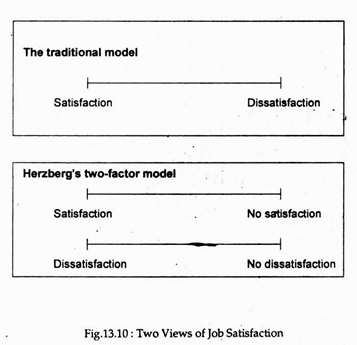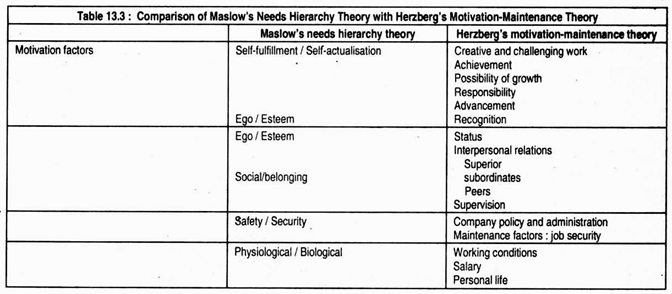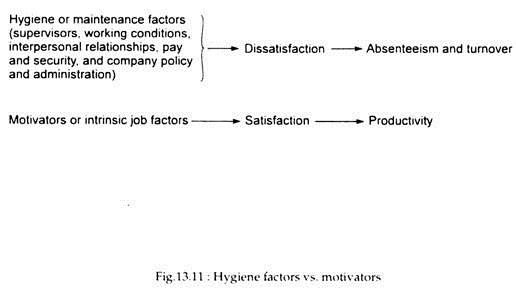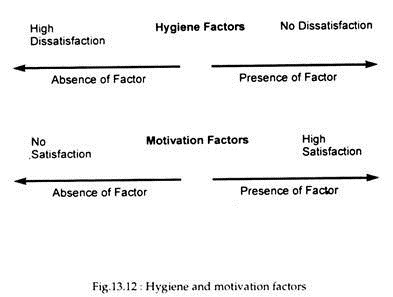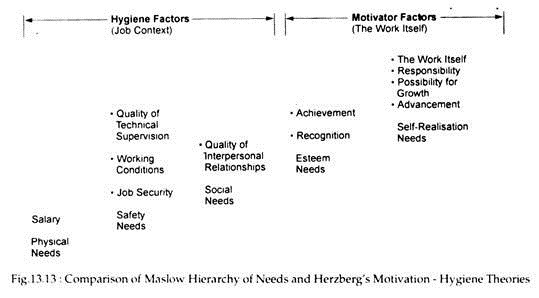Another popular content perspective on motivation is the two-factor theory developed by Fredrick Herzberg. This provides univerlistic perspective on work motivation — a perspective deem deem-phasising individual differences — and is derived from Maslow’s work. It is also known as motivation-hygiene theory or motivation-maintenance theory.
They conducted a series of interviews with 200 engineers and accountants focusing on factors considered to be important as sources of motivation.
Each engineer was asked two questions:
(1) Can you describe, in detail, when you felt exceptionally bad about the job?
(2) Can you describe, in detail, when you felt exceptionally good about the job? From the replies received Herzberg discovered one set of factors that produce job satisfaction and motivation and another set of factors that lead to job dissatisfaction.
Although ‘low pay’ might well be described as causing dissatisfaction, ‘high pay’ would not necessarily be taken as a cause of satisfaction. Instead, different factors, such as recognition or accomplishment, were cited as satisfying.
This finding led Herzberg to arrive at the conclusion that the traditional model of job satisfaction was incomplete. As shown in Fig.13.10, the traditional view holds that satisfaction and dissatisfaction are at opposite ends of a single continuum. But Herzberg’s interviews had identified two different set of factors: one ranging from satisfaction to no satisfaction and the other ranging from dissatisfaction to no dissatisfaction.
Table 13.2 lists the two sets of factors identified by Herzberg as causing either satisfaction or dissatisfaction. The factors influencing the satisfaction continuum are called motivation factors and they are related specifically to the work content. The other set of factors (the one causing dissatisfaction) Herzbeg called hygienic factors; they are related to the work context, i.e., work environment.
Motivating factors have uplifting effects on attitude or performance. Hygienic (or maintenance) factors prevent loss of morale or effectiveness. Although they cannot by themselves motivate human beings, they can forestall any serious dissatisfaction or drop in productivity.
The factors parallel Maslow’s concept of a hierarchy of needs. The motivations relate to the two highest levels (esteem and self-fulfillment), and the hygiene factors relate to the two highest levels (esteem and self-fulfillment), and the hygiene factors relate to the lower-level needs, primarily the security needs (Table 13.3).
Herzberg then argues that there are two stages in the process of motivating employees. First, the manager must ensure that the hygiene factors are adequate. That is, pay and security must be appropriate, working conditions must be safe, technical supervision must be acceptable, and the like.
By providing these factors at an appropriate level, the manager does not stimulate motivation but merely ensures that employer become ‘not dissatisfied’. Employees whom managers attempt to ‘satisfy’ via hygienic factors alone will put the minimum effort to avoid job loss.
Managers should then proceed to the next stage- they should give employees the opportunity to experience motivation factors such as achievement and recognition. The result is predicted to be a high level of satisfaction and motivation. Herzberg also goes one step ahead of others to describe exactly, how to use the two-factor theory. Specifically, he recommends job enrichment. He argues that jobs should be redesigned to provide higher levels of the motivation factors.
The implication is that today’s employees expect to be treated fairly by their managers so as to maintain their individual rights. They expect decent working conditions and wage and salaries comparable to that of people doing similar job in other organisations. They expect company policies to be consistently and equitably applied to all employees.
If these expectations are not realised, employees are demotivated (or negatively motivated). This condition is usually reflected in inefficiency and a high turnover rate (i.e., frequent resignation). But fulfilling these expectations does not necessarily motivate employees.
As Maslow’s theory maintains, it is only when the lower-level needs are satisfied that the higher-level needs can be most effectively used in motivating people. The key is for the manager to tap the motivating factors. The two sets of factors listed may now be illustrated.
Hygiene (or maintenance) Factors:
When an engineer or an accountant described times he felt unhappy on the job he usually referred to such factors like pay, the technical competence of his supervisor, his relations with other employees, company policies and administration, working conditions and job security.
These factors are extrinsic to the job — that is, they do not relate directly to a person’s work, to its real nature. They do not relate directly to the actual work an engineer or accountant performs. They are part of a job’s environment – its context, not its content. Herzberg classified them as hygiene factors which are the primary cause of unhappiness on the job. When the employer is unable to provide enough of these factors to its employees, there will be job dissatisfaction.
However, if they are provided in sufficient quality, they will not necessarily act as motivators — stimuli for growth or greater effort. They will just lead employees to experience no job dissatisfaction.
Some of these factors are the following:
1. Company policies and administration — the policies of the organisation and the fairness in administering those policies.
2. Quality of technical relationships — whether the employee is able to get satisfactory answers to job-related questions.
3. Interpersonal relationships — quality of interpersonal relations among peers, supervisors, and subordinates implying social opportunities as well as the development of comfortable operating relationships.
4. Salary — adequate wages and compensation and sufficient fringe benefits.
5. Job security — company grievance procedures and seniority privileges.
6. Working conditions — adequate heat, light, ventilation and hours of work.
7. Employee benefits — Medical facilities, insurance and terminal benefit (pensions, PF, gratuity, etc.)
8. Job status — privileges, job titles, and other symbols of rank and position.
9. Personal life — relationship with other members of the family, composition of the family, life-style, etc.
Motivation Factors:
However, when an engineer or accountant described times he felt good about the job, he talked about having completed an important task quite successfully- “having been singled out for praise for being effective, having a sense of responsibility for his own or others’ work, and getting a promotion. Since these factors relate more to the content of the job than to its context, they are called intrinsic factors.”
These are intrinsic to a job because they relate directly to the real nature of the job people do. Herzberg termed these factors motivation (or growth) factors or, simply, motivators. These factors are able to move people to complete their work efficiently.
These motivation factors are the primary cause of job satisfaction. If the employer is unable to provide these factors in sufficient quality to employees, they will have no job satisfaction. On the contrary adequate provision of these factors will ensure high performance by providing job satisfaction. However, these motivation factors differ from individual to individual.
Different people require different kinds and degrees of motivation factors. To people who desire them, such factors with the right amount of quality act as stimuli for psychological and personal growth.
The most important of such factors are the following:
1. Achievement—opportunity and scope for accomplishment and for contributing something of value when presented with a challenge.
2. Recognition — acknowledgment that contributions have been worth the effort and appreciation of the effort put.
3. Responsibility — acquisition of new duties and responsibilities, either by delegation or through the expansion of a job.
4. Advancement — opportunity to improve one’s organisational position as a result of job performance.
5. Creative and challenging work — opportunity for self-expression, personal satisfaction, and challenge.
6. Possibility of growth on the job — opportunity to enhance knowledge and develop through job experiences.
Independence:
According to Herzberg, these two sets of factors are quite independent of each other.
While evaluating these two sets of factors M. J. Gannon comments:
“Hygiene factors can make a worker dissatisfied, but do not contribute significantly to his sense of satisfaction with a job. Motivation factors affect the individual’s sense of intrinsic satisfaction but not dissatisfaction.”
According to Herzberg, a worker who becomes very much dissatisfied with the hygiene factors — such as pay or relations with other employees — usually attempts to escape from the work place by coming in late, or being absent, or eventually resigning. However, hygiene factors are unlikely to have any significant influence on an individual’s level of productivity.
On the contrary, growth factors have a direct bearing on the individual’s level of productivity, without affecting such factors as lateness, absenteeism, and turnover. The independence of these two sets of factors is shown in Fig.13.11.
These two sets of factors may also be represented in an alternative way. See Fig.13.12.
Fig.13.12 highlights the point that the hygiene factors operate in a range between no dissatisfaction if they are present in the work environment, to a high degree of job satisfaction if they are totally absent.
On the contrary, if the motivation factors are present in the work environment, workers will enjoy a high degree of job satisfaction. The absence of these factors implies lack of job satisfaction altogether.
In Fig. 13.13 we venture to compare Maslow’s and Herzberg’s views of needs. A close examination reveals that Herzberg’s hygiene factors are quite akin to Maslow’s physiological, safety and affiliation need levels. Likewise, the motivators are quite similar to his esteem and self-realization needs.
